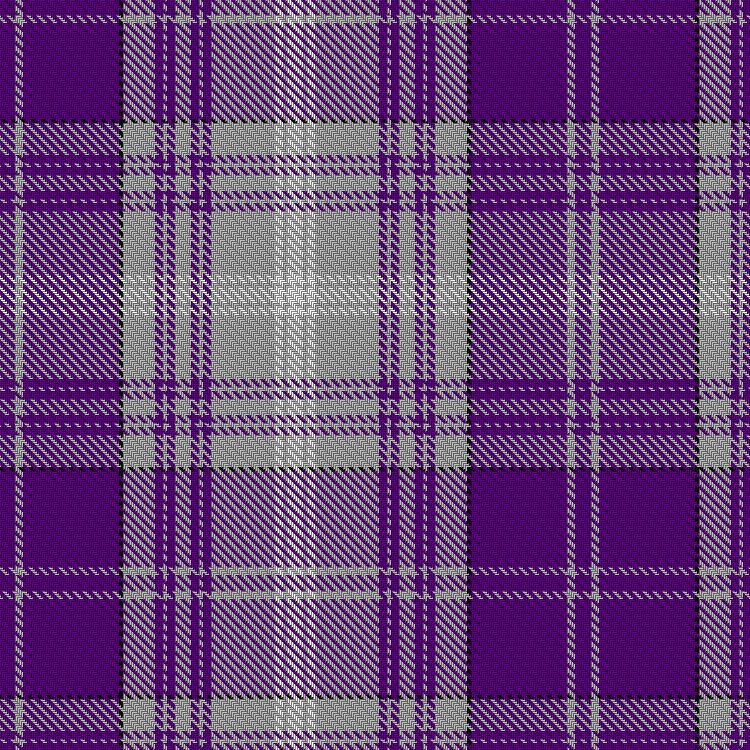Click the tartan to view its entry in The Scottish Registers of Tartans which includes registration details, restrictions, and registrant information.
Unregistered tartans may link to one of the web's online design environments for similar information.
For any questions about reproduction of designs or weaving of these tartans, please contact the registrant directly or via this website.
Purple Day
"🎶 I never meant to cause you any sorrow
I never meant to cause you any pain
I only wanted to one time to see you laughing
I only wanted to see you
Laughing in the purple rain."
~ Purple Rain, Prince and The Revolution, 1984
From lavender to lilac, periwinkle to plum, today is the perfect day to wear purple—or to try your hand at some playful purple alliteration! How about: “The Purpled-Plaided Piper of Perth Pranced Past Pitlochry!"
The colour purple has long been associated with royalty and nobility. Its regal status dates back to ancient times, beginning with the famed Phoenician dye known as Tyrian Purple. This luxurious dye, extracted from the spiny dye-murex sea snail, was incredibly costly to produce, making it a symbol of wealth and power. Roman magistrates, Byzantine emperors, Holy Roman emperors, and Roman Catholic bishops all favoured this rare hue—until supply shortages forced bishops to adopt scarlet instead.
Throughout the centuries, purple remained a highly restricted colour. Sumptuary laws governed its use, and by the 4th century CE, only the Roman emperor himself was allowed to wear Tyrian purple. Children born to reigning emperors were given the special title porphyrogenitos, meaning "born in the purple."
That exclusivity changed in 1856, thanks to a happy accident by eighteen-year-old British chemistry student William Henry Perkin. While attempting to synthesize quinine, he instead created the first synthetic aniline dye—a brilliant purple shade he called mauveine. The industrial production of purple had begun, and mauve quickly took the fashion world by storm.
One modern icon forever linked with the colour was Prince Rogers Nelson—simply known as Prince. The legendary American artist was a masterful multi-instrumentalist and a pioneer of the Minneapolis sound, blending funk rock, synth-pop, and new wave. His tribute tartan, named after his iconic 1984 anthem “Purple Rain”, features his signature hue. Fittingly, purple is also the colour for Epilepsy Awareness Day (also known as Purple Day)—a cause close to Prince’s heart, as he suffered from the condition during childhood. 💜 🤍 💜 🤍 💜
Designed by David McGill as a tribute to late American recording artist, Prince, in the hopes that this would make "Prince the “greatest tartan icon ever," the colours in this tartan reflect the namesake album and song, "Purple Rain."
Purple is the international colour of Epilepsy Awareness Day also called Purple Day. Prince Rogers Nelson (1958-2016) was born epileptic and revealed publicly in 2009 about the effect that this had on his childhood. He credited divine intervention with giving him the strength to cope with his condition.
The purple colour of lavender is the signature color for epilepsy awareness - historically lavender (both the colour and the plant) have been used for the calming effect on the electrical impulses in the brain associated with this nervous system disorder.
Known for his innovative and eclectic work, flamboyant stage presence, extravagant dress and makeup, and wide vocal range, his music integrated a wide variety of styles, including funk, rock, R&B, new wave, soul, psychedelia, and pop.
To date, the Purple Rain album has sold over 22 million copies worldwide, becoming the sixth best-selling soundtrack album of all time.
Prince explained the meaning of "Purple Rain" as follows: "When there's blood in the sky – red and blue = purple... purple rain pertains to the end of the world and being with the one you love and letting your faith/god guide you through the purple rain."
Click the picture of Prince to read about the inspiration for this tartan.









